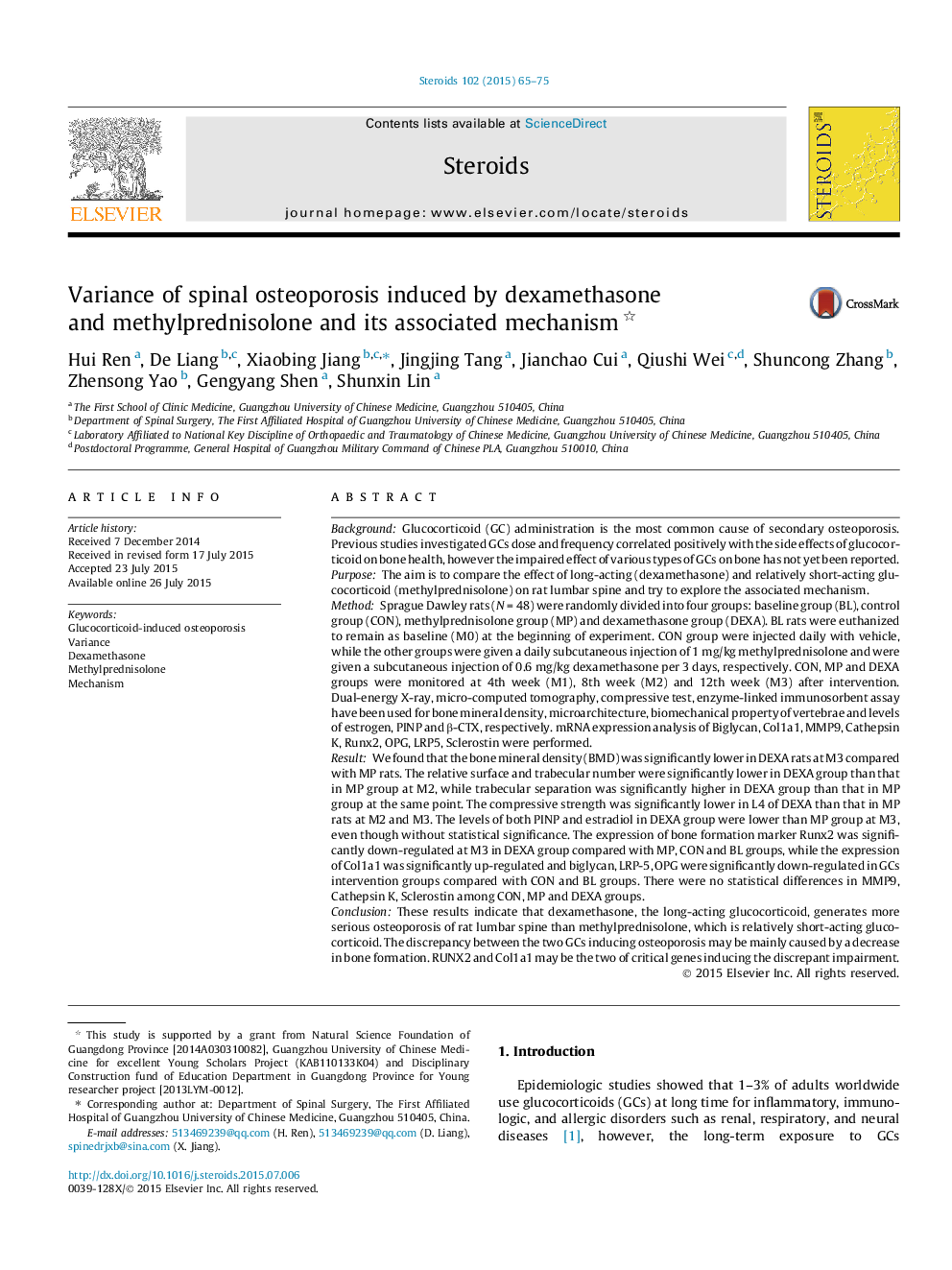| کد مقاله | کد نشریه | سال انتشار | مقاله انگلیسی | نسخه تمام متن |
|---|---|---|---|---|
| 2027546 | 1542706 | 2015 | 11 صفحه PDF | دانلود رایگان |
• We compare the side effect of dexamethasone and methylprednisolone on rat spine.
• Dexamethasone may generate more serious osteoporosis in rat spine than methylprednisolone.
• The discrepancy between the two GCs inducing osteoporosis may be mainly caused by a decrease in bone formation.
• RUNX2 and Col1a1 may be the two of critical genes inducing the discrepant impairment.
BackgroundGlucocorticoid (GC) administration is the most common cause of secondary osteoporosis. Previous studies investigated GCs dose and frequency correlated positively with the side effects of glucocorticoid on bone health, however the impaired effect of various types of GCs on bone has not yet been reported.PurposeThe aim is to compare the effect of long-acting (dexamethasone) and relatively short-acting glucocorticoid (methylprednisolone) on rat lumbar spine and try to explore the associated mechanism.MethodSprague Dawley rats (N = 48) were randomly divided into four groups: baseline group (BL), control group (CON), methylprednisolone group (MP) and dexamethasone group (DEXA). BL rats were euthanized to remain as baseline (M0) at the beginning of experiment. CON group were injected daily with vehicle, while the other groups were given a daily subcutaneous injection of 1 mg/kg methylprednisolone and were given a subcutaneous injection of 0.6 mg/kg dexamethasone per 3 days, respectively. CON, MP and DEXA groups were monitored at 4th week (M1), 8th week (M2) and 12th week (M3) after intervention. Dual-energy X-ray, micro-computed tomography, compressive test, enzyme-linked immunosorbent assay have been used for bone mineral density, microarchitecture, biomechanical property of vertebrae and levels of estrogen, PINP and β-CTX, respectively. mRNA expression analysis of Biglycan, Col1a1, MMP9, Cathepsin K, Runx2, OPG, LRP5, Sclerostin were performed.ResultWe found that the bone mineral density (BMD) was significantly lower in DEXA rats at M3 compared with MP rats. The relative surface and trabecular number were significantly lower in DEXA group than that in MP group at M2, while trabecular separation was significantly higher in DEXA group than that in MP group at the same point. The compressive strength was significantly lower in L4 of DEXA than that in MP rats at M2 and M3. The levels of both PINP and estradiol in DEXA group were lower than MP group at M3, even though without statistical significance. The expression of bone formation marker Runx2 was significantly down-regulated at M3 in DEXA group compared with MP, CON and BL groups, while the expression of Col1a1 was significantly up-regulated and biglycan, LRP-5, OPG were significantly down-regulated in GCs intervention groups compared with CON and BL groups. There were no statistical differences in MMP9, Cathepsin K, Sclerostin among CON, MP and DEXA groups.ConclusionThese results indicate that dexamethasone, the long-acting glucocorticoid, generates more serious osteoporosis of rat lumbar spine than methylprednisolone, which is relatively short-acting glucocorticoid. The discrepancy between the two GCs inducing osteoporosis may be mainly caused by a decrease in bone formation. RUNX2 and Col1a1 may be the two of critical genes inducing the discrepant impairment.
Journal: Steroids - Volume 102, October 2015, Pages 65–75
